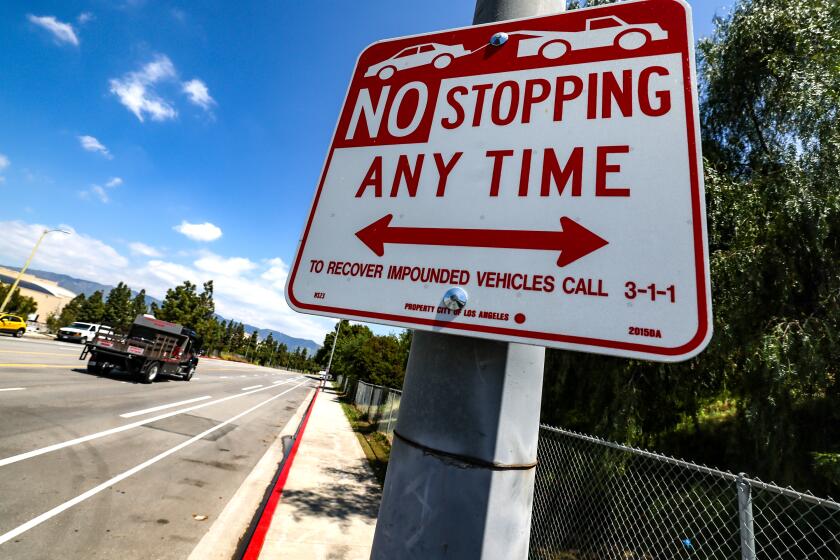L.A. County may spend money to try to save money on welfare

With the cost of helping Los Angeles County’s welfare recipients expected to hit $1 billion by the end of this fiscal year, county officials are pushing a plan to shift the burden of some of the most hard-core unemployed to the federal government. If they succeed, local taxpayers could save tens of millions of dollars, and thousands of disabled welfare recipients would see their aid more than triple.
But the hurdles could prove high. County officials propose spending $7.2 million to help applicants through a notoriously difficult process to qualify for federal disability assistance. The question remains: Does it make sense for the county to gamble millions now with massive state budget cuts looming?
L.A. County is projected to have nearly 100,000 general relief recipients by June, the highest in more than a decade, as more jobs are lost and unemployment benefits run out. General relief is intended as a short-term hand up for single adults.
A separate welfare program, CalWorks, provides cash aid for families with children and is also growing. As the welfare rolls swell, the county faces $114 million in state welfare cutbacks.
At the same time, the county’s general relief payments are the lowest in the state among areas with comparable housing costs. Los Angeles County’s recipients receive $221 a month, an amount set a decade ago during the Clinton-era push to move people from welfare to work.
“No one thinks that’s adequate,” said Philip K. Browning, the county’s director of social services.
But even with some of the lowest cash aid of any urban county in the nation, cash payments are expected to reach $200 million this fiscal year. Nearly $800 million more will be spent on other social services for general relief recipients, including medical care and law enforcement costs, according to county projections.
Costliest among those recipients are people like Kevin Moore, 41, a schizophrenic alcoholic who dropped out of school in fourth grade. Moore went on county welfare earlier this year after finishing a two-year prison sentence for trying to hit his fiancee with his car. While incarcerated, Moore lost his home, bank account and job.
Officials believed that Moore’s mental health problems would qualify him for federal Supplemental Security Income assistance and that shifting him to the program would be mutually beneficial.
On federal aid, Moore would cost the county nothing. Instead of a couple of hundred dollars a month, he could get up to $850. Instead of relying on emergency rooms at county expense, he would qualify for Medi-Cal. To improve his chances, Moore was among the first 1,300 welfare recipients to participate in two new county programs that provide SSI applicants with subsidized housing and other assistance.
Although federal welfare reform in 1996 shifted millions of unemployed workers away from government handouts and into job training, many of the most desperate remained on county-funded welfare, including the disabled, mentally ill and homeless.
A county-commissioned study released this summer found that a third of general relief recipients surveyed had a disability that would qualify them for federal aid. Considering all county resources that are used to help them, those with disabilities cost nearly 70% more than the average recipient, researchers found.
To help those people apply for federal aid, county officials propose spending $7.2 million on caseworkers, housing subsidies and medical evaluations and research. The county chief executive’s staff and welfare advocates are still developing the proposal, which the board plans to consider Sept. 29.
“I know it’s money at a tough time, but it is an investment,” Browning said. “If this can prove to be effective, which we believe it can, it can be the model for other jurisdictions and for us to expand.”
If 4,000 people were moved off general relief and onto federal assistance, the county would save $50 million after a year, according to the county’s chief executive’s office.
County supervisors’ staffers met earlier this month to discuss their overall approach to welfare, and some supervisors have said they support the focus on shifting welfare recipients to SSI.
“Not only are you creating savings, but you’re creating a real connection, a staff of people that are going to help these folks qualify for services,” said Supervisor Gloria Molina.
Supervisor Mark Ridley-Thomas, whose district includes a third of those on general relief, said the plan is an effort to better serve the needy, salvaging good policy from a tight budget. “We don’t run government one day at a time. We have to project how savings over the long term can be achieved and services can be provided to people who desperately need them,” he said.
Earlier this year, the county social services commission recommended that supervisors increase monthly welfare payments to $400, citing high housing costs. But county leaders said that given budget cuts, they could not expect help from the state or afford to spend without the promise of future savings.
“Just increasing cash assistance is very short-sighted,” said Supervisor Don Knabe, who chairs the board. “You need to deal with the systemic issues: How do we remove them from the county system, find them housing and employ them? It’s sort of become a way of life. Obviously, it hasn’t worked.”
The line waiting for general relief at the county’s busiest social services office, in Rancho Dominguez near Compton, snaked across the parking lot on a sunny Friday morning earlier this summer. There were 95 people, many of them new applicants.
It was a light day, staffers said. They have been seeing 60% more people since January, up to 300 a day. Many in line were attempting to get SSI and housing.
Rocky McCohn, 47, of Los Angeles was waiting for information about his SSI application. McCohn was working as a bus driver in 2002 when he suffered heart failure. Soon after, he went on welfare, gave up his apartment and began staying with friends.
His SSI application was delayed, he said, because he could not afford bus fare to collect necessary medical paperwork to prove he is disabled. The federal applications require detailed medical evaluations and doctors’ reports that, if incomplete, trigger a long reapplication process.
As of July it took the downtown Los Angeles SSI office an average of 99 days to process a new application. If an application is rejected twice, an applicant can appeal for a hearing before an administrative judge. The average wait for a hearing is about a year, said Leslie Walker, a spokeswoman at the Social Security Administration’s San Francisco regional office.
SSI applications are up 12.5% this year in California, with about 241,000 filed, Walker said. She said they were already gearing up for a “huge onslaught of more claims” next fiscal year driven by aging baby boomers.
The administration has hired 157 new judges to handle hearings nationwide this year and plans to hire about 200 next year, Walker said. Her office hired 94 more staff members to help process applications and plans to hire six more by year’s end and 100 more next year. Overtime hours have also been added.
But that may not be enough to avoid a backlog. Workers processing SSI applications are paid by the federal government but considered state employees subject to the governor’s three-day-a-month furloughs.
Moore, the former convict, was ultimately successful, showing the potential for the county plan to work.
When he applied on his own, he was twice rejected because federal officials said he failed to document his disabilities. Under the new programs, county caseworkers gave him bus tokens and clothing vouchers so he could get to doctors’ appointments and gather his medical records.
With the added help, Moore’s application was approved in May. Now he receives about $700 in federal assistance, which he uses to pay for clothes, food and rent at a downtown complex run by the Skid Row Housing Trust. Instead of expensive visits to the emergency room at County-USC Medical Center, he gets regular checkups and visits to a psychiatrist, funded by Medi-Cal.
Sitting in his furnished room, Moore said he plans to take literacy and cooking classes so he can one day work in a restaurant or start his own catering business.
“I can move on with my life,” he said.
molly.hennessy-fiske @latimes.com
More to Read
Start your day right
Sign up for Essential California for news, features and recommendations from the L.A. Times and beyond in your inbox six days a week.
You may occasionally receive promotional content from the Los Angeles Times.







